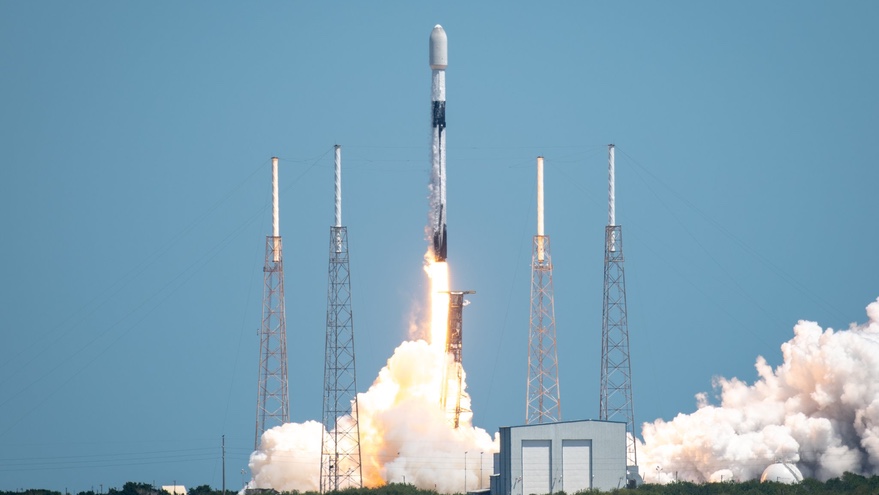Products You May Like
WASHINGTON — SpaceX continued the rollout of its Starlink broadband constellation with another launch of 60 satellites April 7, edging closer to providing continuous global service.
A Falcon 9 lifted off from Space Launch Complex 40 at Cape Canaveral Space Force Station at 12:34 p.m. Eastern. The rocket’s upper stage deployed its payload of 60 Starlink satellites into orbit a little more than an hour later.
The rocket’s first stage landed on a droneship in the Atlantic eight and a half minutes after liftoff. This was the seventh flight for this booster, which first launched the Demo-2 commercial crew mission last May and most recently launched another set of Starlink satellites March 11.
This was the 10th Falcon 9 launch of the year for SpaceX, eight of which have been dedicated to Starlink satellites. The company now has 1,378 satellites in orbit when accounting for those launched and subsequently deorbited, according to statistics maintained by Jonathan McDowell.
That constellation is now nearing the size needed to provide at least basic service globally. “We do have global reach, but we don’t have yet have full connectivity globally,” Gwynne Shotwell, president and chief operating officer of SpaceX, said during an April 6 panel discussion at the Satellite 2021 LEO Digital Forum.
“We hope after about 28 launches we’ll have continuous coverage throughout the globe,” she added. This launch is the 23rd of v1.0 satellites, although a few v0.9 satellites launched nearly two years ago remain in orbit, along with 10 v1.0 satellites launched into polar orbit on a rideshare mission in January. That suggests the company will reach the continuous coverage milestone after four to five more launches.
Those launches would push SpaceX against its current FCC authorization, which allows the company to operate up to 1,584 satellites in orbits at approximately 550 kilometers. The company’s current license from the Federal Communications Commission allows it to operate 2,825 additional satellites at altitudes of 1,100 to 1,300 kilometers. SpaceX had filed a request with the FCC to modify that license, moving those additional satellites to 550 kilometers.
The FCC has yet to rule on that modification, but SpaceX’s current launch rate means the company will hit its current limit of satellites at 550 kilometers within a couple months. Shotwell mentioned during the panel that the company is “bringing our satellites down from our original altitude” to address space sustainability concerns. She did not, though, address the FCC license modification issue beyond saying that the company would continue launching satellites “as we’re allowed.”
Shotwell said the company would press ahead with Starlink launches even after hitting the threshold of continuous global coverage. “The plan after that is to continue to add satellites to provide additional capacity,” she said. That includes launching additional satellites to polar orbit beginning this summer from Vandenberg Air Force Base in California. Those polar satellites, she said, will likely include laser intersatellite links that the company has experimented with on a few Starlink satellites.
The element of the overall Starlink effort that has attracted the most attention is the series of launches that has created the world’s largest satellite constellation in less than two years. That has not necessarily been the biggest challenge for SpaceX, though.
“The satellites and launch have been pretty straightforward for us. We thought we’d struggle a little bit more on the satellites, but it turns out our Dragon, which is a very sophisticated satellite, helped us tremendously in figuring out the satellite architecture for Starlink,” she said.
What has been a challenge, she said, is dealing with a growing number of customers and building a reliable network, but “none of which we can’t solve.”
Starlink remains in a beta test in the United States and several other countries. Shotwell said there are no plans to end the beta test and move into full commercial service in the near future. “We still have a lot of work to do to make the network reliable,” she said. “We’ll move out of beta when we have a really great product that we are very proud of.”
Another area of effort has been on the ground equipment used by Starlink subscribers, notably the electronically steerable antenna. Shotwell said the company has been working to reduce the cost of that equipment, which is required to win wide-scale adoption.
“We have made great progress on reducing the cost of our terminal,” she said. That equipment originally cost about $3,000. “We’re less than half of that right now.”
Customers currently pay about $500 for that equipment, meaning that SpaceX is still significantly subsidizing those terminals. That may change, though, as the company makes continued progress to lower costs. “We do see our terminals coming in the few-hundred-dollar range within the next year or two.”
Shotwell appeared on a panel with executives of several other satellite operators, many of whom argued that hybrid systems that use satellites in low and medium Earth orbits as well as geostationary orbit, or GEO satellites alone, offer better solutions. “We see absolutely no way, no possibility, that those low-orbit constellations can fulfill the latent demand of all the unserved population today,” said Rodolphe Belmer, chief executive of Eutelsat.
As Belmer and other executives on the panel expressed their reservations about LEO constellations, Shotwell smiled. “I just always smile, by the way, when people make projections about what can and can’t be done with technology,” she said. “I don’t think we have any idea how technology can evolve five years from now.”
